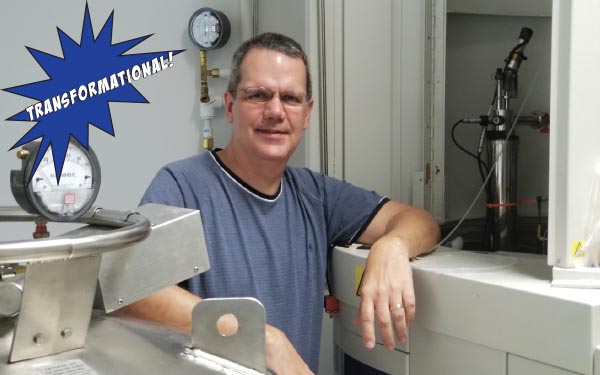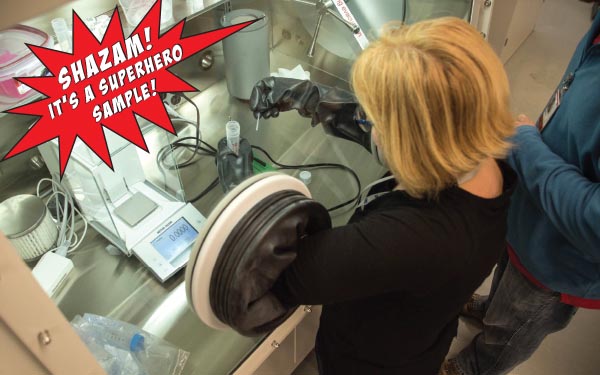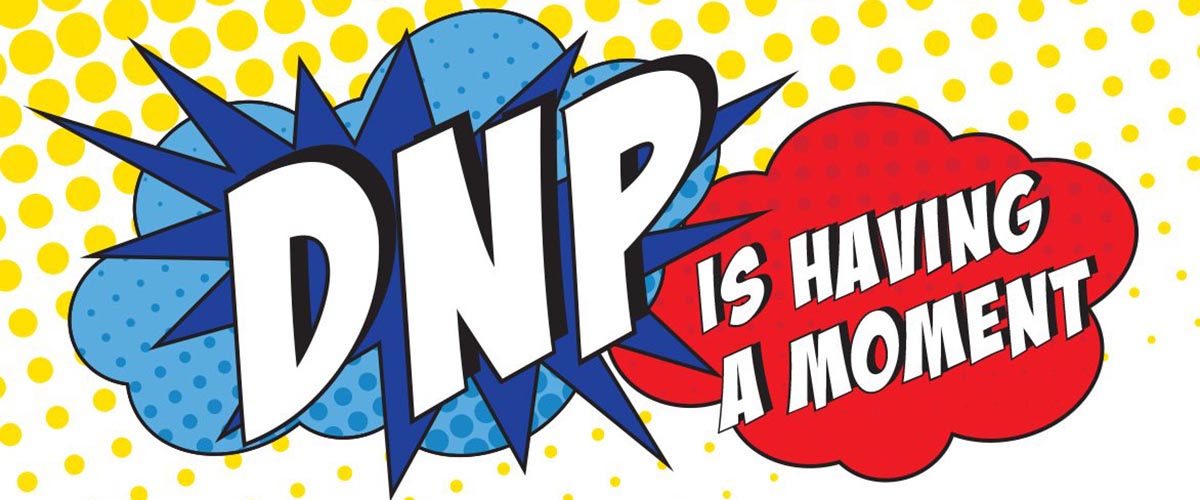There was darkness. Then dimness. Then, at last, there was light.
In the era before nuclear magnetic resonance (NMR), scientists trying to map out complex molecules like proteins had few tools to work with. Then, in the 1950s, the first NMR commercial instruments came online. Using magnetic fields and radio waves, the revolutionary technique shone some light on those molecular mysteries, identifying atoms and how they fit together.
The problem was, NMR worked better detecting some atoms than others. And even the "easy" atoms took days, sometimes months to sort out, due to their relatively weak signals.
Then came the dawn of DNP.
For decades scientists have been developing dynamic nuclear polarization, or DNP, to address NMR's shortcomings. Now, thanks to the availability of higher magnetic fields and the tenacity of DNP pioneers, researchers can see molecule-level structures and processes in unprecedented detail and at astonishing speeds.
"We had to iron out the nitty-gritty hardware stuff," said Joanna Long, director of a facility devoted to NMR, magnetic resonance imaging (MRI) and DNP experiments at the National High Magnetic Field Laboratory. "We kind of waded through our Dark Ages. And now we’re in the Renaissance. Suddenly, we know how to handle the technology and use it for all kinds of good things."
An increasing number of commercial DNP instruments can now be found in labs and hospitals around the world. Scientific publications that reference the technique have increased more than sixfold in the past decade. Researchers are regularly discovering new uses for DNP, probing brain metabolism (as Long’s group does), outwitting fungal infections, even making sure your toothpaste is doing its bacteria-killing job (see The Case of the Zinc in the Toothpaste.
DNP, clearly, is on a roll.
There are still plenty of details to figure out, DNP developers say, and some approaches are advancing more smoothly than others. But for newcomers willing to tweak experiments and reshape their questions, the technique promises to unlock all kinds of science mysteries.
DNP is NMR on steroids. It boosts the pianissimo signals of the atoms scientists want to tune into with the help of fortissimo electrons. Here's how it works.
NMR machines leverage a magnetic property inherent to the nuclei of all atoms called "spin" or "magnetic moment." Thanks to spin, nuclei can align, or polarize, with or opposite a magnetic field. Combining that field with radio waves, NMR machines manipulate and read these alignments, which are exquisitely sensitive to the chemical environment. These quantum acrobatics send signals to a detector to disclose the target atom’s whereabouts, helping scientists piece together a molecule’s structure.
Many important biological elements, including carbon, are not particularly sensitive to this technique. Accumulating enough data to hear those faint signals can take weeks, even months, running up experimental costs.
This is where DNP amps things up.
When atoms have an odd number of electrons, that oddball — called an unpaired electron — has a lot more spin than a nucleus. So in DNP NMR, scientists add molecules called polarizing agents, which have these unpaired electrons, to the sample. Simply put, DNP polarizes those electrons first, then transfers that energy to the target atoms — a kind of domino effect. In this way, a far greater proportion of target atoms get polarized, resulting in a fortissimo signal that is orders of magnitude stronger than in conventional NMR.
Bravo, DNP!
Different DNP methods address different science questions. The first to generate big results in living systems was dissolution DNP. And Matt Merritt was among the initial scientists to use it.
It was an experiment he’ll never forget.
A decade ago, Merritt was a young professor studying heart metabolism at the University of Texas Southwestern Medical Center. His group there had acquired one of the first commercial dissolution DNP systems. In this kind of DNP, scientists initially polarize atoms in a solution, then inject that solution into an animal or tissue sample placed inside an MRI machine (MRIs are a kind of NMR machine). Then they observe what happens as the substance is metabolized.

Matt Merritt says DNP-based metabolic imaging will transform medical science in the next few years.
Photo courtesy of Matt Merritt
In Merritt's first foray into DNP, he injected polarized acetate into the heart of a rat. (When not immediately used for energy, acetate gets stored by the body in the compound acetylcarnitine.) Merritt then went to his computer to observe the signals. In NMR experiments, data appear on a screen in a series of peaks (similar to those on a heartbeat monitor), each denoting the presence of a particular compound.
"Then this peak just popped up," remembered Merritt: It was the molecular fingerprint of acetylcarnitine. He had just watched a heart put acetate in storage … while it was actually happening.
"I've never seen that before," Merritt thought as he stared. "Nobody has ever seen that before."
Now an associate professor of biochemistry and molecular biology at the University of Florida (UF), Merritt is quite used to seeing things never before seen. Dissolution DNP has mushroomed, with more than 50 systems worldwide, including about 20 used for human patients in hospitals.
Merritt uses the National MagLab's DNP system at UF to study metabolism in the liver. Specifically, he looks at the chemical reactions the body uses to release stored energy, known as the Krebs cycle. After polarizing the carbon in the compound dihydroxyacetone (DHA, or C3H6O3), he injects it into the liver of a mouse and measures the metabolic uptake and disposal of the agent. This provides unprecedented insight into both glycolysis and Krebs cycle metabolism.
There, the compound does one of two things, Merritt has observed: It gets turned into glucose for immediate use in the body, or it's drawn into the Krebs cycle, where it helps make the energy-storing molecule ATP for other liver functions.
Merritt hopes the discoveries he is making will shed light on why nonalcoholic fatty liver disease, which is relatively harmless, sometimes leads to nonalcoholic steatohepatitis (NASH), a serious condition projected to become the main cause for liver transplants in the next 20 years.
"Hopefully," Merritt prognosticated, "we can develop some kind of imaging exam that would say, 'Hey, you're on the verge of developing NASH. We need to intervene immediately.'"
Other kinds of metabolic imaging might one day help detect cancer cells (which could become visible after metabolizing polarized glucose into lactate) and warning signs of a heart attack (energy metabolism changes when the heart is stressed).
"We are within five years of using DNP-based metabolic imaging to transform medical science," Merritt continued. "We just don't know exactly how — yet.”
Another approach to DNP, called MAS DNP, helps scientists unravel the molecular structure of complex solids, such as proteins.

Tuo Wang (left) and Fred Mentink-Vigier study the cell walls of fungi.
Photo by Stephen Bilenky
The Ph.D.'s behind these experiments are true spin doctors. MAS stands for magic angle spinning, and refers to a special rotor inside the magnet that whirls the proteins (or other samples) around thousands of times a second, a necessary trick for getting the right signals from most solid samples.
MAS DNP has boomed since Bruker Corp. put the first commercial instrument on the market in 2009. By mid 2018, more than 30 were in use worldwide. One is at the National MagLab, where scientists like Tuo Wang of Louisiana State University come to learn the ropes from the experts.
What has Wang been taking for a spin? Fungi, which are responsible for infections that claim more than 1.5 million lives a year worldwide.
In conventional NMR, researchers usually look at purified samples, extracting from cells just the molecules they're interested in. But for his research, Wang needs a more realistic picture. To better understand the cell wall structure, he studies the interactions between lignin and cellulose there and what happens to carbon in the molecules at that interface. This requires looking at the cells in situ. Because the target atoms are fewer and farther between in this native environment, scientists need the sensitivity of MAS DNP to see them.
Wang is the first to look at the whole cell of this system in its native state at such high resolution, he said. He was able to collect data so quickly this year that he already has one publication on the topic under his belt, and several more in the pipeline.
His team's next step with DNP: Expose the fungus to different drugs.
"We'll see how the drugs really react in the cell," Wang said, "and we'll see what kind of molecular insight we can provide to design better drugs."
Every new application means new issues to trouble-shoot, said Fred Mentink-Vigier, a physical chemist who runs the MAS DNP program at the National MagLab. For Wang's experiments, for example, Mentink-Vigier had to figure out how to turn off the microwaves on the instrument while taking measurements in order to remove unwanted signals.
If that sounds hard, imagine building the first MAS DNP instruments from scratch. That was the job of one of the original spin doctors, MIT chemist Robert Griffin.
In the mid 1980s, Griffin was studying a protein called bacteriorhodopsin, found in the retina. In a remarkable sequence of steps scientists were (and still are) keen to better understand, the protein uses energy from a photon of light to initiate a nerve impulse.
"Understanding how a biological system works so efficiently is something that is of tremendous interest," said Tim Cross, director of the NMR facility at the National MagLab. "If we could harness this technology for an energy source, it would be fantastic. And bacteria have been doing this for millennia."
When Griffin tried conventional NMR to study how ions were crossing cell membranes during this photocycle, he got a lot of noise in his data. It's like trying to listen to a song on your car radio when the station is out of range: You're picking up signals, but the static makes it hard to hear the music.
"We did a lot of experiments without DNP," remembered Griffin. "But it became very apparent very, very quickly that if we had a big signal-to-noise enhancement technique, and we could do spectroscopy at low temperatures, we could learn a lot more about the system."
That turned out to be a pretty ambitious "if." MAS DNP didn't exist yet. He would have to build it. Some doubted it could be done, but Griffin was in it for the long haul.
"He was the lone voice saying it was going to work out and it was going to be great for everyone," recalled Joanna Long, a former graduate student of Griffin's.
There were plenty of hurdles, including building a gyrotron to generate the frequency of microwaves his set-up required. But eventually it paid off with an instrument that could detect the subtle signals of the carbon, nitrogen and hydrogen he was trying to map. Today, Griffin’s lab at the Francis Bitter Magnet Laboratory boasts several home-built DNP systems.
Now when Griffin examines the bacteriorhodopsin photocycle using MAS DNP, very cold temperatures and lasers of different colors, he can capture incredible details at specific stages that shed light on how hydrogen crosses cell membranes.
"What we're interested in is how this proton pump works, how this inward-directed hydroxyl pump works," Griffin said. "And in order to understand that, we have to trap various intermediates in this photocycle."
The MAS DNP improved the signal-to-noise ratio by a factor of 75, Griffin said, making the experiment thousands of times faster.
"It's an enormous time savings," said Griffin, who also uses MAS DNP to study the amyloid protein fibers associated with neurodegenerative disease. "You just couldn't do these experiments without this increase in sensitivity."
While dozens of commercial instruments are in use worldwide for dissolution and MAS DNP, a third DNP technique, Overhauser DNP, has proven a tougher puzzle. But when those pieces come together, it will fill a vast void by allowing scientists to study molecules in liquids at low concentrations.

Elzbieta Miegel combines a polarizing agent, solvent and target molecules in a tube for an Overhauser DNP experiment.
Photo by Stephen Bilenky
Several teams around the world are developing the technique. At the National MagLab, physicist Thierry Dubroca has devoted several years to assembling a machine and getting it to work.
But that may have been the easy part.
"We have a good instrument," Dubroca said. "Now we need good samples."
Easier said than done, it turns out. Preparing good samples for Overhauser DNP requires savvy chemical matchmaking: You need to pair the sample with the right polarizing agent, which itself must be paired with the right solvent.
To assist with this challenge, Dubroca recently recruited chemist Elzbieta Miegel of the University of Warsaw, who designs and assembles polarizing agents for other applications. All polarizing molecules feature at least one unpaired electron, which is the electron used to transfer spin to the target nucleus. Through some educated trial-and-error, Dubroca and Miegel have learned more about which polarizing agents work well for Overhauser DNP, and which solvents work well to dissolve those molecules into the sample.
"It's a very small step, but it's critical," Dubroca said. "It does not allow you to publish a paper. But you need that as one of the many little steps before you can even do the science that will give you a paper."
Eventually, Dubroca said, Overhauser will generate plenty of journal articles. Once up, running and debugged, he believes it will make thousands of molecules in biological samples visible to scientists, a huge leap over the 100 or so accessible via NMR today. One day, he envisions, doctors could even use Overhauser DNP right in their offices to diagnose patients by differentiating between "sick" and "healthy" levels of molecules in the body.
Dubroca has a lot to figure out between now and then.
"That's how science works," he said. "We're trying really hard to get the liquid DNP figured out and then the next stage is to make it user friendly."
In the meantime, more and more scientists are discovering DNP's power. One colleague described the experience to MIT's Griffin last year as a "DNP moment."
"That's a moment when you do an experiment that you've tried to do for years, but you didn't have enough signal-to-noise to do it," Griffin recounted. "And all of a sudden — wow — this huge signal pops out at you in a very short period of time."
It's what you might call seizing the moment — the DNP moment.
Story by Kristen Coyne. Story science advisor: Kendra Frederick.








